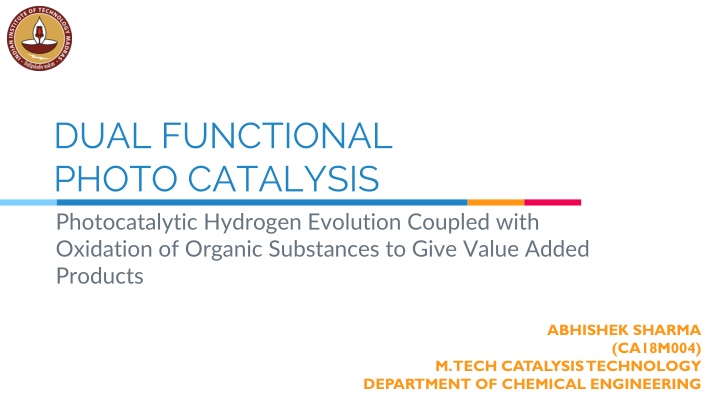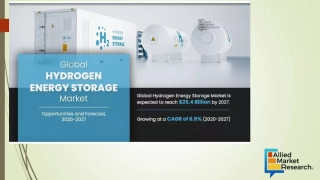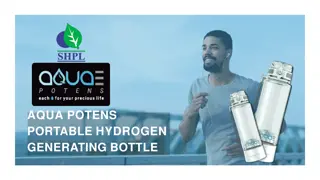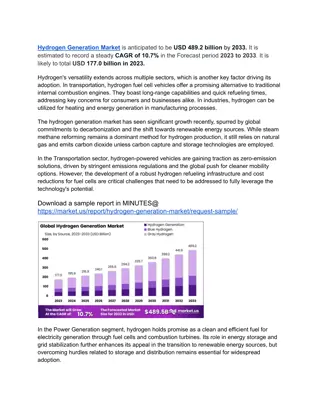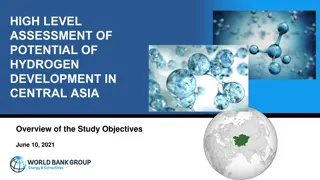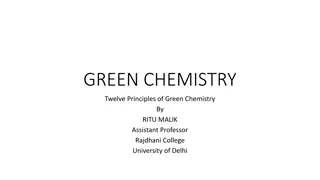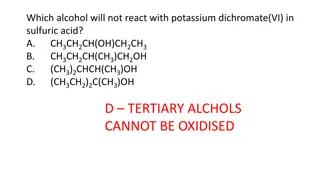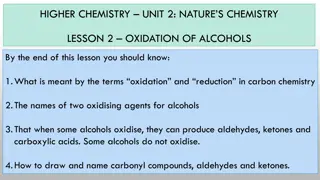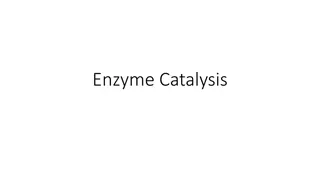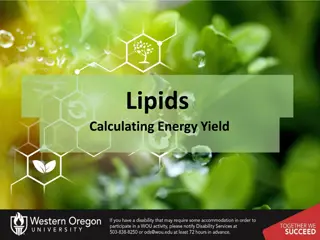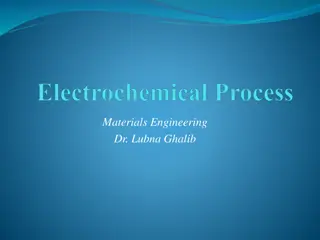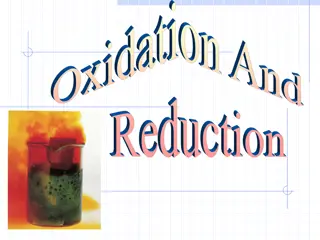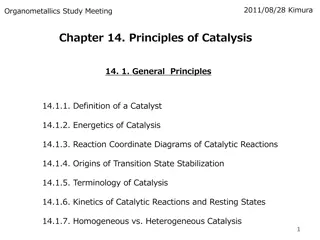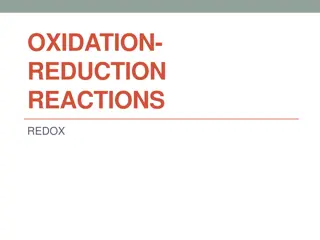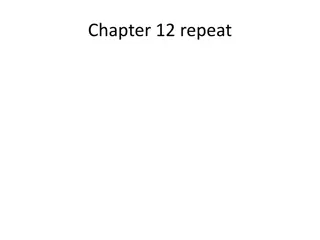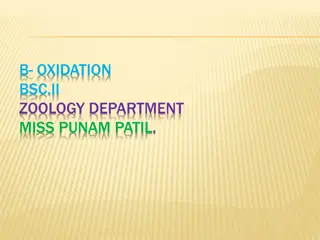Dual-Functional Photo Catalysis: Hydrogen Evolution & Organic Oxidation
The research explores dual-functional photo catalysis, combining hydrogen evolution with the oxidation of organic substances to produce value-added products. It focuses on utilizing photoelectricity to create electrons for hydrogen production and organic molecule oxidation. The study investigates the oxidation of benzylamine to N-benzylbenzaldimine and the effects of electron donors and acceptors on the reaction rates and selectivity. By employing materials like metal organic frameworks (MOFs), the process aims to improve sustainability and efficiency in chemical transformations.
Download Presentation

Please find below an Image/Link to download the presentation.
The content on the website is provided AS IS for your information and personal use only. It may not be sold, licensed, or shared on other websites without obtaining consent from the author.If you encounter any issues during the download, it is possible that the publisher has removed the file from their server.
You are allowed to download the files provided on this website for personal or commercial use, subject to the condition that they are used lawfully. All files are the property of their respective owners.
The content on the website is provided AS IS for your information and personal use only. It may not be sold, licensed, or shared on other websites without obtaining consent from the author.
E N D
Presentation Transcript
DUAL FUNCTIONAL PHOTO CATALYSIS Photocatalytic Hydrogen Evolution Coupled with Oxidation of Organic Substances to Give Value Added Products ABHISHEK SHARMA (CA18M004) M. TECH CATALYSIS TECHNOLOGY DEPARTMENT OF CHEMICAL ENGINEERING
Stavroula Kampouri and Kyriakos C. Stylianou, Dual-Functional Photocatalysis for Simultaneous Hydrogen Production and Oxidation of Organic Substances, ACS Catal. 2019, 9, 4247 4270 2
Introduction Chemical industry processes Expensive Environmental impact Required organic transformations to be Energy sustainable Environmentally friendly A promising approach by employing photo catalysis Transformation with a wide variety of materials to Value-added chemicals Clean solvents High-energy-density biofuels Lang, X.; Chen, X.; Zhao, J. Heterogeneous visible light photocatalysis for transformations. Chem. 473 486. selective Rev. organic Soc. 2014, 43, Herbst, A.; Janiak, C. MOF catalysts in biomass upgrading towards value-added fine chemicals. CrystEngComm 2017, 19, 4092 4117. 3
Concept Use of photoelectricity to create Electrons in CB Holes in VB Electrons Reduce H+to H2 Evolution CO2to C Metal ore to metal Holes Oxidation of O2-to O2 Oxygen Evolution Oxidation of Organic molecules Hydrogen Major photocatalytic field 4
Oxidation of Benzylamine to N-Benzylbenzaldimine Liu, H.; Xu, C.; Li, D.; Jiang, H.-L. Photocatalytic Hydrogen Production Coupled with Selective Benzylamine Oxidation over MOF Composites. Angew. Chem., Int. Ed. 2018, 57, 5379 5383 Feng, D.; Wang, K.; Su, J.; Liu, T.-F.; Park, J.; Wei, Z.; Bosch, M.; Yakovenko, A.; Zou, X.; Zhou, H.-C. A Highly Stable Zeotype Mesoporous Zirconium Metal Organic Framework with Ultralarge Pores. Angew. Chem., Int. Ed. 2015, 54, 149 154. Catalyst PCN-777 Zr oxo clusters and 4,4 ,4 -(1,3,5-triazine-2,4,6-triyl)tribenzoic acid based mesoporous MOF Mainly UV light active Highly stable Oxidation of benzylamine to N-benzylbenzaldimine Combined with Pt Photocatalytic generation of H2 H2evolution Schematic representation of simultaneous photocatalytic proton reduction and selective benzylamine oxidation over Pt/PCN777 5
Cntd Effects of electron donar and acceptor H2evolution TEOA as an electron donor Rate 586 mol h 1 g 1 Benzylamine as an electron donor Rate 332 mol h 1 g 1 In the absence of any electron donor Rate was significantly lower Benzylamine oxidation to N-benzylbenzaldimine Rate 1512 mol h 1 g 1 More than 99% selectivity AgNO3 as electron scavenger Rate 486 mol h 1 g 1 Selectivity remained over 99% Dibenzylamine oxidative dehydrogenation and cinnamyl alcohol oxidation, was also successful Liu, H.; Xu, C.; Li, D.; Jiang, H.-L. Photocatalytic Hydrogen Coupled with Selective Oxidation over MOF Composites. Angew. Chem., Int. Ed. 2018, 57, 5379 5383 Production Benzylamine 6
Change in ligand use of MOF-808 Another Zr based MOF Containing a shorter ligand trimesic acid Pt/MOF-808 Unsatisfactory photocatalytic activity for both half-reactions Better photocatalytic performance of PCN-777 Elongated and highly conjugated ligand Extends the light absorption Improves charge separation Manifested by Photocurrent Open circuit photovoltage Electrochemical impedance spectroscopy DFT calculations HOMOs and LUMOs within PCN-777 are spatially spaced Longer excited state lifetime Better electron hole separation Cobo, S.; Dominguez-Ramos, A.; Irabien, A. Minimization of Resource Consumption and Carbon Footprint of a Circular Organic Waste Valorization System. ACS Sustainable Chem. Eng. 2018, 6, 3493 3501. 7
Selective Oxidation of Different Benzyl Alcohols Catalyst Pt-modified graphitic carbon nitride photocatalytic system (Pt-g- C3N4) Favorably operated under visible light Demonstrated better conversion and H2yields with Alcohols bearing electron-donating and withdrawing functional groups Comparison to the unsubstituted benzyl alcohol Inadequate selectivity for aldehydes The same phenomenon was observed with Cyclohexanol or cinnamyl alcohol Reason of poor selectivity Strong oxidative nature of the photo generated holes Basis Detailed analysis of the reaction intermediates Carbon balance over 20 hrs. Li, F.; Wang, Y.; Du, J.; Zhu, Y.; Xu, C.; Sun, L. Simultaneous oxidation of alcohols and hydrogen evolution in a hybrid system under visible light irradiation. Appl. Catal., B 2018, 225, 258 263. 8
Catalyst modification Ru-based molecular complex Oxygenation catalyst [Ru(tpa)(H2O)2]2+(RuCat, tpa = tris(2-pyridylmethyl)amine) Photo generated holes transferred from g-C3N4 to the Ru based catalyst Forming Ru(IV)=O species High-valent and very catalytically active 4-methoxybenzyl alcohol oxidation to 4-methoxybenzyl aldehyde Selectivity improved notably Selectivity decreased slightly (91%) During long-term irradiation of 20 h Partial decomposition of the molecular catalyst Not the case for the Pt/g-C3N4 Retained whose stability and reusability for at least five consecutive runs Li, F.; Wang, Y.; Du, J.; Zhu, Y.; Xu, C.; Sun, L. Simultaneous oxidation of alcohols and hydrogen evolution in a hybrid system under visible light irradiation. Appl. Catal., B 2018, 225, 258 263. 9
Oxidation of 5-hydroxymethylfurfural (HMF) to 2,5- diformylfuran Optimum Zn content, P-doped Zn0.5Cd0.5S, Performance 72 times ZnS-P 7.5 times CdS-P 5-hydroxymethylfurfural to oxidation half cell H2evolution rate 786 molh 1 g 1 Boosted to twice of higher value After 8 h of visible-light irradiation HMF conversion ~40% DFF selectivity around 65% P doped ZnxCd1 xS solid solutions Studied for water splitting Afterward replaced water oxidation half-reaction Results for water splitting Undoped ZnxCd1 xS did not produce H2 Advantage of interstitial P doping Elongated lifetime of charge carriers High separation efficiency of photo generated electrons holes Ye, H.-F.; Shi, R.; Yang, X.; Fu, W.-F.; Chen, Y. P-doped ZnxCd1 xS solid solutions as photocatalysts for hydrogen evolution from water splitting coupled with photocatalytic oxidation of 5hydroxymethylfurfural. Appl. Catal., B 2018, 233, 70 79. 10
H2Generation with Simultaneous Plastic Waste Management 11
Use of CdS/ CdOx QDs as Photo-catalyst Ambient-temperature plastic waste photo reforming strategy Implementing CdS/ CdOxQDs In alkaline media Under simulated solar light Photo excited holes Oxidize substrate to smaller organic molecules Electrons reduced water to H2 The most favorable conditions = 430 nm Identified through Optimization of the photo catalyst, NaOH, and substrate concentrations H2evolution rate 64.3 0.85 mmol h 1g 1 Comparison with 5% Pt/TiO2 H2evolution rate 0.011 0.074 mmol h 1g 1 TiO2is a wider-band-gap (3.2 eV) Uekert, T.; Kuehnel, M. F.; Wakerley, D. W.; Reisner, E. Plastic waste as a feedstock for solar-driven H2 Energy Environ. Sci. 2018, 11, 2853 2857. generation. Examined polymers Poly lactic acid (PLA) Polyethylene terephthalate (PET) Polyurethane (PUR) 12
Major Drawbacks Catalyst Disintegration Catalyst are not stable and starts losing their activity even after first run Organic Dissociation Organic molecule dissociates Side reactions can yield CO and CO2 Hydrogen purification Removal of unwanted CO and CO2 Energy extensive for high purity Increase plant size and hence production cost Scale up limitations Scale up decrease photo harvesting efficiency Non continuous Depends on sun s radiations 13
Thanks! Any questions? You can find me at: asabhi0081@gmail.com & ca18m004@smail.iitm.ac.in 14
